Abe (“Yukon Jack”), Santa Fe, NM
back to 2025 SF2T Finishers main page
Abe did the thru-hike through a particularly wet and cold stretch we had this summer. But he hung in and finished anyway.
I started from my house in Santa Fe on August 19. I walked about two miles up to the plaza, sat on a bench for a while, found the Old Santa Fe Trail monument, and started walking again. All of the streets and trails as far as Tesuque Creek were familiar to me, and I spent the night under a large ponderosa a ways up from the Juan Trail. Day two was miserable for me, and I found myself exhausted, with quite a bit more climbing to do, huddling in the rain under the trailhead sign at the Norski Trailhead. I called my wife, found the blue bus schedule on line, and came pretty close to throwing in the towel. I’m glad I didn’t, because over the days ahead I relearned moisture management techniques and realized any time the sun was covered my mood would worsen, but any time the sun shined life was great.
Moisture management, by the way, includes frequent wardrobe changes, closing and opening armpit zippers as needed, drying socks, underwear, and rain jacket on the outside of the pack when it’s sunny, covering the pack when it’s rainy, keeping a few core items like your sleeping bag in a dry bag, keeping your stuff covered if it’s raining when you’re pitching your tent, cooking in your vestibule, monitoring and preventing ingress of water on the tent floor, wearing moist clothing inside your sleeping bag so it dries from your body heat over night, and packing up as much as you can inside the tent in the morning if it’s raining. No big deal. Few things are more beautiful than hiking at high altitude as a fog is lifting in the morning sun.
On three different mornings, I took the unusual (for me) step of setting my alarm for 4:00 AM and starting to hike by 6:00. It was still too dark at 6:00 to hike without a headlamp. I did this to clear the high country along Trailriders Wall, the Santa Barbara Divide, and Ripley Point before the afternoon thunderstorms, and to give myself time to resupply (including battery charging) at the Tres Ritos resupply. Unfortunately, I was unable to unlatch the door to the resupply in Tres Ritos, but Pam drove up and magically opened it for me. It was nice to meet her, and it would have been somewhat devastating for me if she didn’t.
Being a long time Santa Fe resident, I had already hiked almost all of the trails as far as Ripley Point, but none of the trails north of there. It was really great to revisit and tie together so many Pecos Wilderness trails, and to visit such a special area north of there for the first time. I can now say I’ve hiked the entire Winsor Trail (I had never hiked it between the Borrego Trail and ski area before). I was really impressed with how ecologically intact the Rio Grande del Rancho, Rito de la Olla, and Rio Chiquito watersheds are, despite the logging history, road access, and density of closed roads. When I was younger, I explored more parts of New Mexico with little or no recreational use, and over time have come to focus on areas in New Mexico and beyond more popular for backpacking. It was refreshing to rediscover how wonderful a less popular area can be. I thought it was every bit as beautiful as the Jemez Mountains. One of the two days hiking when I didn’t see another person was the day hiking up the Rio Grande del Rancho, over to the Rito de la Olla, and up that stream to the Bernardin Lake area. The other day with no people sighting was from Pecos Baldy Lake to the West Fork Rio Santa Barbara, the most spectacular section of the whole hike, in my opinion.
I camped at the following locations:
- Tesuque Creek upstream of the Juan Trail
- Nambé Lake Trail in the meadow recommended in the book
- A mile past Stewart Lake next to a marsh
- The meadow where the Rito del Perro Trail meets the Dockweiler Trail (mentioned in the book as Rito del Perro Field)
- Pecos Baldy Lake
- West Fork Rio Santa Barbara (the only overgrazed area in the whole hike)
- A tributary of Agua de Piedra Creek mentioned in the book
- La Cueva Canyon not far from the bench
- A meadow on the Rio Grande del Rancho (I caught a brown trout there)
- A meadow on the Rito de la Olla near Bernardin Lake
- A meadow in Drake Canyon about a mile from the Rio Chiquito (dry camping)
During the last two days of hiking, I enjoyed being at lower altitudes with the attendant biodiversity and warmth. Getting into Taos was nice. That was a long day of hiking, but I was in better condition by then. Plus, it was mostly downhill. I had some ice cream at the Taos Cow (the kitchen closes at 3:00), walked on down to the plaza via some back streets (adding distance, but I got to see some interesting neighborhoods), and then from there to the El Pueblo Lodge. My wife met me there, and we had a wonderful short vacation in Taos.
I completed this hike in 12 days. In the future, I would add one zero day (camping two nights at the same place), at a place where the fishing might be good. Cave Creek looked promising, as did any of the three main streams north of Tres Ritos. The West Fork Rio Santa Barbara is known for fishing, but the grazing and constant presence of actual cows make it less inviting.
I’ve made a few through hikes, and while this is not the John Muir Trail, it feels like home to me, and is more challenging in some ways than the JMT or Colorado Trail. And there’s much more solitude, of course. I might do it again next year!



